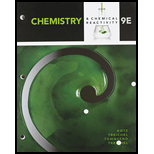
Concept explainers
What is the N—O bond order in nitrogen monoxide, NO?
- (a) 2
- (b) 2.5
- (c) 3.0
- (d) 1
Interpretation:
The nitrogen monoxide (
Concept Introduction:
Molecular orbital (MO) theory: is a method for determining molecular structure in which electrons are not assigned to individual bonds between atoms, but are treated as moving under the influence of the nuclei in the whole molecule.
Bond order: The bond order has defined as the net number of bonding electrons pairs linking a pair of atoms. This same concept can be applied directly to molecular orbital theory, but not bond order is defined as.
Answer to Problem 1RC
The nitrogen monoxide (NO) molecule bond order has 2.5, and option (b) is correct one.
To determine: The nitrogen monoxide (NO) molecule bond order should be identified.
Explanation of Solution
Molecular orbital correlation diagram of (NO) molecule
Calculation method of bond order of (NO) molecule
The nitrogen monoxide (NO) molecule bond order was calculated.
Want to see more full solutions like this?
Chapter 9 Solutions
Bundle: Chemistry & Chemical Reactivity, Loose-Leaf Version, 9th + OWLv2, 4 terms (24 Months) Printed Access Card
- True or false? In general, a large atom has a smaller electro-negativity. Explain.arrow_forwardThe thiocyanate ion, SCN‒, can form bonds to metals through either S or N (see Problem 5.23). What is the likelihood of cyanide, CN‒, forming bonds to metals through N as well as C?arrow_forwardExplain why N2 2+ is diamagnetic, while O2 4+, which has the same number of valence electrons, is paramagnetic.arrow_forward
- 8,9?arrow_forward(c) Theoretically, define the following elements in the formulae belowPth = ρghq x ŋarrow_forwardAn ionic compound, LiN((CH3)3Si)2 is commercially available and can be synthesised by deprotonation of ((CH3)3Si)2NH with C4H9Li. Draw an orbital diagram and a sketch to show the overlap of orbitals that produce the bonding in ((CH3)3Si)2N− anion and predict whether the Si−N−Si bond angle in the ((CH3)3Si)2N− anion is larger than, equal to or smaller than 109.5. explainarrow_forward
- Discuss how the bond order and # of unpaired electrons change when an eletron is added O2- and an electron is ionized, O2+.arrow_forwardQuestion 7:a) State the number of possible electrons described by the following quantum numbersa) n = 3, l = 0b) n = 3, l = 2, ml = -1c) n = 5, l = 0, ml -2, ms -1/2b) Give the n and l values for the following orbitalsa. 3s b. 4d c. 5fQuestion 8:a) Which of the following is a polar molecule? CCl4; CO2, CH4, CH3Cb) What does it mean when a molecule is said to be polar?c) Which of the molecules below would not form hydrogen bonds?CH3OH; CH3OCH3; CH3COOH; NH3d) Place the following ions in order from smallest to largest ionic radii: P3-, K+, Na+, and Cl-arrow_forward(i) What is the covalency of N in N2O5 ?(ii) Explain why phosphorus forms pentachloride whereas nitrogen andbismuth do not?arrow_forward
 Chemistry & Chemical ReactivityChemistryISBN:9781133949640Author:John C. Kotz, Paul M. Treichel, John Townsend, David TreichelPublisher:Cengage Learning
Chemistry & Chemical ReactivityChemistryISBN:9781133949640Author:John C. Kotz, Paul M. Treichel, John Townsend, David TreichelPublisher:Cengage Learning General Chemistry - Standalone book (MindTap Cour...ChemistryISBN:9781305580343Author:Steven D. Gammon, Ebbing, Darrell Ebbing, Steven D., Darrell; Gammon, Darrell Ebbing; Steven D. Gammon, Darrell D.; Gammon, Ebbing; Steven D. Gammon; DarrellPublisher:Cengage Learning
General Chemistry - Standalone book (MindTap Cour...ChemistryISBN:9781305580343Author:Steven D. Gammon, Ebbing, Darrell Ebbing, Steven D., Darrell; Gammon, Darrell Ebbing; Steven D. Gammon, Darrell D.; Gammon, Ebbing; Steven D. Gammon; DarrellPublisher:Cengage Learning
 ChemistryChemistryISBN:9781305957404Author:Steven S. Zumdahl, Susan A. Zumdahl, Donald J. DeCostePublisher:Cengage Learning
ChemistryChemistryISBN:9781305957404Author:Steven S. Zumdahl, Susan A. Zumdahl, Donald J. DeCostePublisher:Cengage Learning Chemistry: An Atoms First ApproachChemistryISBN:9781305079243Author:Steven S. Zumdahl, Susan A. ZumdahlPublisher:Cengage Learning
Chemistry: An Atoms First ApproachChemistryISBN:9781305079243Author:Steven S. Zumdahl, Susan A. ZumdahlPublisher:Cengage Learning Chemistry for Engineering StudentsChemistryISBN:9781337398909Author:Lawrence S. Brown, Tom HolmePublisher:Cengage Learning
Chemistry for Engineering StudentsChemistryISBN:9781337398909Author:Lawrence S. Brown, Tom HolmePublisher:Cengage Learning





